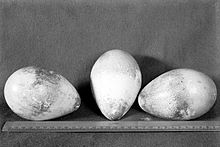Apsley Cherry-Garrard
During the remainder of the southern summer, from January to March, Cherry-Garrard helped lay depots of fuel and food on the intended route of the party which would attempt to reach the South Pole.
With Wilson and Henry Robertson Bowers, Cherry-Garrard made a trip to Cape Crozier on Ross Island in July 1911 during the austral winter in order to secure an unhatched emperor penguin egg to hopefully help scientists prove the evolutionary link between all birds and their reptile predecessors by analysis of the embryo.
[5] In almost total darkness, and with temperatures ranging from −40 to −77.5 °F (−40.0 to −60.8 °C), they man-hauled their sledge 60 miles (100 km) from Scott's base at Cape Evans to the far side of Ross Island.
Frozen and exhausted, they reached their destination in 19 days and built an improvised rock wall igloo with canvas roof on the slopes of Mount Terror just a few miles from the penguin colony at Cape Crozier.
The igloo roof lasted one more day before it too was ripped away by the wind, leaving the men in their sleeping bags under a thickening drift of snow, singing songs and hymns above the sounds of the storm to keep their spirits up.
When the winds subsided on 24 July, by great fortune they found their tent lodged in a hollow drift at the bottom of a steep slope half a mile away.
Cherry-Garrard later referred to this as the 'worst journey in the world' at the suggestion of his neighbour George Bernard Shaw, and gave this title to his book recounting the fate of the 1910–1913 expedition.
On 1 November 1911, Cherry-Garrard set off to accompany the team that would make the attempt on the South Pole, along with three supporting parties of men, dogs and horses.
[7] As Cecil Meares was not available for work, Atkinson had to attend to a medical emergency, and George Simpson was busy, the fateful choice fell on Cherry-Garrard.
Belatedly, on 26 February 1912, Cherry-Garrard and dog handler Dimitri Gerov set off southwards and soon reached One Ton Depot on 3 March, and deposited additional food.
On 12 November, the bodies of Scott, Wilson and Bowers were found in their tent, along with their diaries and records, and geological specimens they had hauled back from the mountains of the interior.
[14] At the start of the Great War, Cherry-Garrard, along with the help of his mother and sisters, converted Lamer, his family estate, into a field hospital for wounded soldiers returning from the front.
[15] After this opportunity was cut short, Cherry-Garrard returned to England and was eventually commissioned in the Royal Naval Volunteer Reserve and commanded a squadron of armoured cars in Flanders.
He many times revisited the question of what possible alternative choices and actions might have saved the South Pole team — most notably in his 1922 memoir The Worst Journey in the World.
After the Second World War, ill health and taxes forced him to sell his family estate and move to a flat in London, where he died in Piccadilly on 18 May 1959.





